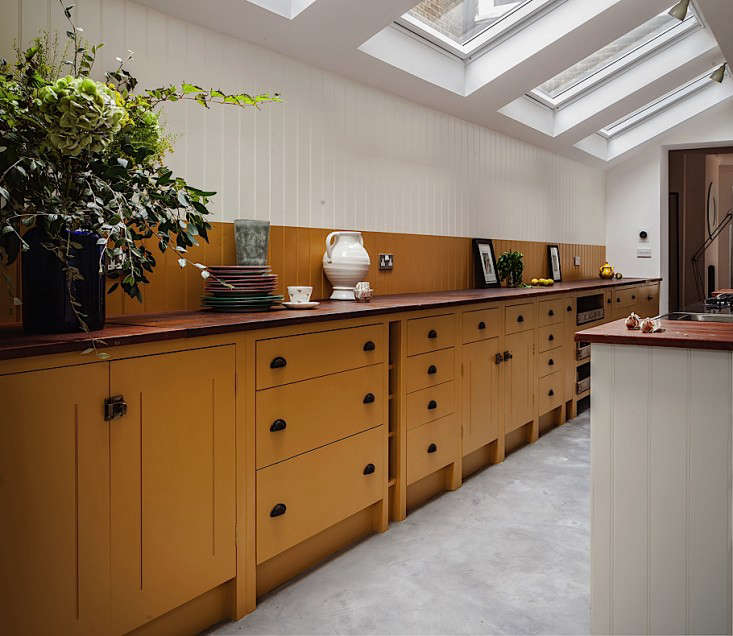In our new weekly series called 10 Things Nobody Tells You, we unpack remodeling basics that first-timers might not know… and reveal a few things even seasoned renovators might find surprising. In this week’s installment, we’re tackling one of the biggest projects homeowners might face: the kitchen remodel. Here are 10 things to consider, down to the outlets.

1. It’s (really) expensive.
According to Remodeling magazine, the national average cost for a full, midrange kitchen remodel is—brace yourself—about $66,000. (The average “upscale” renovation? That can run $131,000.) Homeadvisor.com reports that the largest costs go towards cabinetry and hardware (29 percent), installation (17 percent), and appliances and ventilation (14 percent). Surprisingly, though, Remodeling reports that doing a full-on remodel won’t necessarily boost resale value; on average, home sellers only recoup about 60 percent of the remodeling costs.
It’s a good case for working smarter, not harder, when it comes to kitchen renovations. To make a big impact without the cost, leave the layout as-is so you don’t need to relocate any major hook-ups (see Remodeling 101: The U-Shaped Kitchen, Plus 10 Examples and Remodeling 101: The L-Shaped Kitchen for more on the common kitchen layouts) and do the sourcing yourself.
2. Think about who’s coming to dinner.
Consider that cliché icebreaker question: Who would you invite to a dinner party? More specifically: Will you be hosting elaborate dinners for eight every weekend? Or feeding small kids every night? Or dining solo? Do you bake or cook or both? Imagining your cooking needs and who will be using your kitchen will help you make remodeling decisions, like how many ovens you need. If you want to bake and cook at the same time or entertain frequently, you might consider two; see our breakdown of How to Choose Between a Range, Cooktop, and Wall Oven in the Kitchen.

3. Choosing your countertops is one part aesthetics and two parts practicality.
You’ll also need to imagine your future self in your kitchen when choosing your countertops. If you’re okay with material that requires maintenance (and won’t always look perfect), you might go for marble or soapstone. If you’re on a budget, though, those might be out of reach. Ready to see which is right for you? Here are Five Questions to Ask When Choosing Kitchen Countertops.

4. You should opt for a wall-mounted faucet.
When choosing a faucet, you might be inclined to choose a standard deck-mounted model and not think much about it. But daring to install a wall-mounted faucet, as Julie did in her Brooklyn Heights apartment, is a small choice that can make a big impact. For one thing, it’ll be much easier to keep the area around your sink clean and dry; read more about the pros in Remodeling 101: In Praise of Wall-Mounted Faucets.
5. The unsexy details can make or break your project.
In addition to focusing on big-picture elements like tiling and countertops, don’t forget to plan for proper ventilation (read all about Ceiling-Mounted Recessed Kitchen Vents) and outlets (see Where to Locate Electrical Outlets, Kitchen Edition). You don’t want to have a beautiful kitchen that fills up with smoke when you cook or requires you to use the mixer on the floor.

6. You can hack your Ikea kitchen cabinets.
There are a lot of cabinet styles out there. Don’t get buried under dozens of choices. When it comes to hardwearing and timeless styles, there are only six types of cabinets you need to know. If you want something affordable that still feels custom, a slew of new companies are hacking Ikea cabinets; see our favorites in Ikea Kitchen Upgrade: 11 Custom Cabinet Companies for the Ultimate Kitchen Hack.
7. A double-bowl sink will work harder than a single-bowl sink.
Sure, a single-bowl sink appears more streamlined and fits better in a small space. But a double-bowl sink means you can divide and conquer dishes, wash vegetables without getting them near dirty plates, and always have access to the disposal. To help you choose, weigh the pros and cons in Single-Bowl Vs. Double-Bowl Sinks in the Kitchen.

8. You can buy pre-owned appliances at a discount.
Think of kitchen appliances like cars: as soon as they leave the showroom, they depreciate. Fortunately you can source hardworking, lightly used appliances at a fraction of the cost, as many homeowners and designers we know have done; for our favorite sources, see Remodeling 101: 8 Sources for Used Appliances.
And before you start looking for a fridge, ask yourself: How often do you go to the grocery store? Do you like to make and freeze meals in bulk? Do you have a petite kitchen? For guidance on what fridge is best for you, consult Remodeling 101: How to Choose Your Refrigerator and Remodeling 101: What to Know When Replacing Your Fridge.
9. Make sure to double-check everything when it arrives.
“On work sites, packages tend to pile up but they’re not always opened. It’s wise to make sure that what you’ve received is exactly what you were expecting down to the color and finish,” advises mother-daughter team Matriarchy Build. Too many times, suppliers have sent the duo the wrong item; it’s important to catch this mistake before workers, who might not know it’s the wrong thing, install it. For more advice on how to avoid renovation perils and pitfalls (like having the wrong thing demo’ed—yes, that’s really happened), see How to Avoid Rookie Remodeling Mistakes: 9 Tips from Mother-Daughter House Flippers Matriarchy Build.

10. You might not need a full remodel.
Remember: the days of big, expensive kitchens are past (even kitchen islands are no longer necessary). There are plenty of ways to work with what you’ve got—like painting your kitchen cabinets, or simply swapping out appliances or tile—and still make a big impact. For ideas, see 10 Things Nobody Tells You About Painting Kitchen Cabinets.
More in this series:
- 10 Things Nobody Tells You About Painting Floors
- 10 Things Nobody Tells You About Subway Tile
- 10 Things Nobody Tells You About Painting Furniture
- 10 Things Nobody Tells You About Washing Your Bedding
- 10 Things Nobody Tells You About the Trendiest Tile of 2019
- 10 Things Nobody Tells You About Renovating Your Bathroom
- 10 Things Nobody Tells You About the Benefits of Wool
- 10 Things Nobody Tells You About Clawfoot Bathtubs
- 10 Things Nobody Tells You About Painting Kitchen Cabinets
- 10 Things Nobody Tells You About Shiplap
- 10 Things Nobody Tells You About Marble Countertops
- 10 Things Nobody Tells You About Painting a Room White




Have a Question or Comment About This Post?
Join the conversation (13)